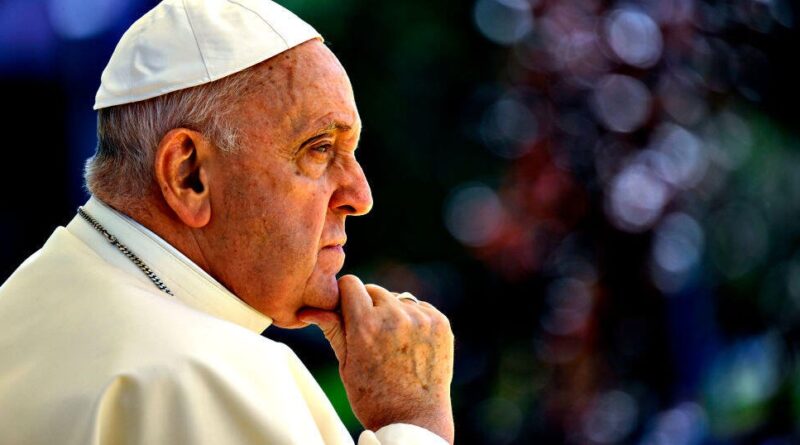Pope Francis’ cause of death was stroke and subsequent irreversible heart failure, Vatican says
Pope Francis’ death Monday at the age of 88 comes after the Catholic leader experienced a number of health issues in recent years.
Francis died at 7:35 a.m. Monday at his residence, the Vatican said. In an statement released Monday, the Vatican said Francis died of stroke and subsequent irreversible heart failure.
The pope, who had part of one lung removed as a young man, long battled health problems and was especially prone to respiratory illnesses in the winter.
In July 2021, he spent 10 days in the hospital following intestinal surgery for a bowel narrowing. In March 2023, he was hospitalized for three days and received intravenous antibiotics for bronchitis. A few months later, in June 2023, he was back in the hospital to have surgery to remove intestinal scar tissue and repair a hernia in the abdominal wall.
Since 2022, he often used a wheelchair, walker or cane due to knee injuries, and he had suffered recently from multiple falls.
Here’s a breakdown of his most recent bout of health challenges earlier this year:
Feb. 6, 2025: Francis was diagnosed with bronchitis, but continued to hold daily audiences — though he handed off his speeches for an aide to read aloud, saying he was having trouble breathing.
Feb. 14, 2025: Francis was hospitalized to treat bronchitis and undergo diagnostic tests. A spokesperson said he was expected to be there for “a few days.”
Feb. 17, 2025: Francis’ respiratory tract infection presented a “complex clinical picture” that required further hospitalization, the Vatican said at the time. Vatican spokesman Matteo Bruni said tests indicated the pope was suffering from a “polymicrobial respiratory tract infection” that called for a further change in his drug therapy.
Feb. 18, 2025: Francis developed bilateral pneumonia, meaning the pneumonia was in both of his lungs. The illness was discovered after Francis underwent a chest CT scan, the Vatican said. According to the statement, Francis was in a good mood and spent the day resting, praying and reading.
Feb. 23, 2025: Francis remained in critical condition as blood tests showed early kidney failure. The Vatican said he remained alert and “well-oriented.” While he hadn’t had any more respiratory crises since the night before, he was still receiving high flows of supplemental oxygen.
Feb. 26, 2025: Blood tests confirmed a slight improvement in the pope’s health, according to a Vatican update, and the slight kidney insufficiency detected a few days prior had receded. Francis continued to receive respiratory physiotherapy to help him expel fluid from his lungs.
Feb. 28, 2025: Francis experienced a bronchospasm, which is when the muscles that line the airways in the lungs tighten. The incident caused him to inhale vomit, but he responded well to being treated with noninvasive mechanical ventilation, according to the Vatican.
March 1, 2025: Pope Francis had a calm night after the bronchial crisis caused a setback to his recovery. In an update, the Vatican said he had coffee, read newspapers and was able to move and sit in his armchair.
March 3, 2025: Francis suffered “two episodes of acute respiratory failure” over the course of the day, which the Vatican said were caused by “significant accumulation of endobronchial mucus and consequent bronchospasm.”
March 8, 2025: The Vatican said Pope Francis was showing “gradual, slight improvement” amid his pneumonia treatment.
March 10, 2025: Doctors said Pope Francis was no longer in imminent danger of death from pneumonia, but they decided to keep him hospitalized longer to receive treatment.
March 14, 2025: Francis marked the 12th anniversary of his papacy from his hospital room. It was also the one-month mark since he was hospitalized.
March 23, 2025: After five weeks, Francis left Rome’s Gemelli hospital after surviving the life-threatening bout of pneumonia.
March 26, 2025: An interview with Dr. Sergio Alfieri, the head of Pope Francis’ medical team, revealed Francis came close to dying on two separate occasions before he was allowed to return to his home at the Vatican over the weekend. Alfieri told an Italian newspaper that the medical team even considered letting the pope die at one critical point on Feb. 28 when Francis had suffered a breathing crisis after inhaling his own vomit during a coughing fit. Alfieri described it as “the worst” day of the pope’s 38-day hospitalization.
and
contributed to this report.

